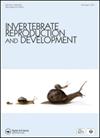自受精扁虫等待时间种群间变化的证据
IF 0.7
4区 生物学
Q4 REPRODUCTIVE BIOLOGY
引用次数: 8
摘要
自交受精(Self-fertilization,自交受精)被认为是在配偶可用性低的情况下保证繁殖的一种进化方式。然而,由于它经常导致近亲繁殖抑制(ID),许多雌雄同体在配偶稀少时通过自交推迟繁殖,以等待潜在的异交机会。由于不同的人口统计历史和配偶可用性导致不同的最优自交倾向,表现出这种延迟自交的物种可能在开始自交的等待时间(WT)上表现出种群间的差异。为了验证这一点,我们量化了两个雌雄同体扁形虫自然种群的WT。在其中一个群体中,我们额外估计了ID和性别分配(SA),它们预计会与自恋倾向共变。我们在这两个种群中都没有发现WT的证据,但在种群中观察到自交后代的ID和SA的可塑性,并测量了这些性状。我们的结果与之前在另一个自然种群中观察到的模式形成鲜明对比,后者表现出大量的WT和相应的自交后代适应性降低。我们的研究确定了该物种在自交倾向方面存在自然多样性,并强调了刻画这种种群间变异的重要性,以进一步了解交配系统的进化。本文章由计算机程序翻译,如有差异,请以英文原文为准。
Evidence for inter-population variation in waiting times in a self-fertilizing flatworm
ABSTRACT Self-fertilization (selfing) is thought to evolve as a way of guaranteeing reproduction when mate availability is low. Nevertheless, because it often leads to inbreeding depression (ID), many hermaphrodites postpone reproduction via selfing when mates are scarce to wait for potential outcrossing opportunities. Owing to varying demographic histories and mate availabilities causing differing optimal selfing propensities, species exhibiting such delayed selfing may show inter-population variation in waiting time (WT) to commence selfing. To test this, we quantified WT across two natural populations of the hermaphroditic flatworm Macrostomum hystrix. In one of the populations we additionally estimated ID and sex allocation (SA), which are expected to covary with selfing propensity. We found no evidence for a WT in either population, but nevertheless observed both ID in the selfed progeny and plasticity in SA in the population we measured these traits. Our results contrast starkly to the pattern previously observed in another natural M. hystrix population, which exhibited a substantial WT and a corresponding reduction in selfed offspring fitness. Our study establishes the presence of natural diversity in selfing propensity in this species and highlights the importance of characterizing such among-population variation to further understand mating system evolution.
求助全文
通过发布文献求助,成功后即可免费获取论文全文。
去求助
来源期刊
CiteScore
1.90
自引率
0.00%
发文量
21
审稿时长
>12 weeks
期刊介绍:
Invertebrate Reproduction & Development ( IRD) presents original research on the reproductive and developmental biology of the Invertebrata, both embryonic and postembryonic. IRD welcomes papers reporting significant results obtained using new techniques. Encouraged topic areas include: aquaculture, physiology, biochemistry, functional morphology, phylogeny, behavioural and regulatory mechanisms, including genetic, endocrine and molecular studies. Papers containing qualitative descriptions of reproductive cycles and gametogenesis will not be considered. IRD is published in association with the International Society of Invertebrate Reproduction and Development.

 求助内容:
求助内容: 应助结果提醒方式:
应助结果提醒方式:


